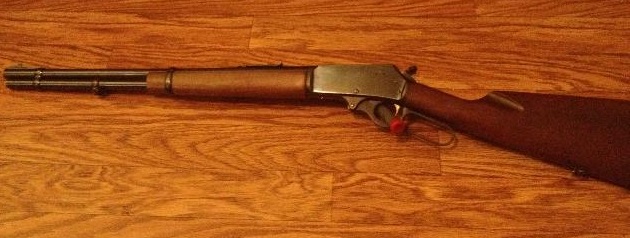The Marauder: Marlin’s short-barreled cowboy gun
While no one ever accused the Marlin 30 series lever action rifle of being too long in the field, the company has from time to time flirted with chopping it down even further. One of the shortest of these was the briefly made 336 Marauder.
The basic platform
Way back in 1893 one LL Hepburn, a gunsmith at Marlin, was issued patent number 502,489 for a new locking bolt system with a two-piece firing pin and rectangular bolt that could be actuated by an under-rifle lever action. The new Hepburn action absolutely forced the head of cartridge against the front of the carrier and into the chamber, while barring the entrance to the magazine, theoretically preventing failure to feeds, or ejects which lever actions were known for. Further, a positive safety button pushed through the action, locking it when activated.
This action, coupled with the single-piece, milled and forged receiver design of the Marlin company’s old Model 1889 rifle (also designed by Hepburn), led to a new gun known as the Marlin Safety Repeating Model 1893. This gun featured a solid frame and top with side ejection. This was something that none of the Browning Winchester’s had. It was cleaner, with less moving parts and therefore less likely to bind up or have debris fall into the action while it was working. The Model 1893 was made in quantity for several years, with production running into the early 1930s.
Then in 1936, the old Model ’93 was upgraded with a curved pistol grip stock with a hard rubber butt plate instead of a strait stock with a steel one, improved forearm, and sights. This cosmetically different gun was renamed the all-new and improved Model 1936. Over time, this moniker changed to the simpler Model 36, then finally Model 336 in 1948. The only thing changed in the action of this final incantation was a rounded alloy steel bolt with chrome plating was substituted for Hepburn’s original rectangular one. This massive bolt is firmly supported in the receiver and engages in a broad, deep locking surface in the breech bolt, giving it a strong breech.
The new Marlin lever gun was fresh from the 1890s with a few tweaks. The basic model came drilled and tapped for Lyman style receiver sights, could accept an over-receiver scope (more about this later), take 7-rounds of .30-.30 in its tubular magazine (although other calibers were available) and had an overall length of 38-inches. Tipping the scales at 6.5-pounds, it was a very handy and capable brush gun for the introductory price of $61 in 1948.
However, around 1953 the company thought the gun could go shorter.
Enter the Texan
By shaving 1.5 inches off the barrel, the company introduced the 336 Texan that came very close to dropping under 6-pounds with its 18.5-inch overall barrel. Chambered in .30-30 and 35 Remington, the gun was also offered in .44 Magnum for a brief period in the 60s. A TS version came in a Model 39-style straight stock rather than the standard pistol grip. Still, Marlin thought they could go shorter…


